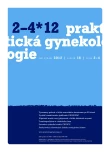-
Medical journals
- Career
Ulipristal acetate: new antiretroviral drug in treatment of uterine fibroids
Authors: Kristýna Kubínová
Authors‘ workplace: Gynekologicko-porodnická klinika 1. LF UK a VFN v Praze, přednosta prof. MUDr. A. Martan, DrSc.
Published in: Prakt Gyn 2012; 16(2-4): 77-79
Category: Gynecology and Obstetrics: Review Article
Overview
In patients with symptomatic uterine fibroids the dominant therapeutic modality is still surgery (hysterectomy, myomectomy) or radiological treatment (uterine artery embolization, focused ultrasound). Causal pharmacological treatment has until recently been limited to the use of Gonadoliberine analogues (GnRHa). In research for the new pharmacological options it was observed that progesterone and its receptors induce proliferative activity in uterine fibroid cells and therefore treatment with antiprogesterones may be used in patients with uterine fibroids. These substances include for example: mifeproston, its effect on fibroid volume reduction has been demonstrated in several clinical trials and telapriston and asoprisnil. The development of telapriston and asoprisnil was stopped in phase III clinical trials due to hepatotoxicity or negative effect on the endometrium. Currently, new per-oral drug containing ulipristal acetate has been introduced to the Czech market. Ulipristal acetate belongs to the so called Selective Progesterone Receptor Modulator (SPRM) family. It has recently completed Phase III clinical trials and has acquired a license for clinical use in Europe. Although further studies are needed to assess the long-term results and safety of prolonged use ulipristal acetate, undoubtedly this drug represents a new and promising treatment option for patients with uterine fibroids.
Key words:
uterine fibroid – Selective Progesterone Receptor Modulator – ulipristal acetate
Sources
1. Levy BS. Modern management of uterine fibroids. Acta Obstet Gynecol Scand 2008; 87(8): 812–823.
2. Donnez J, Tatarchuk TF, Bouchard P et al. Ulipristal acetate versus placebo for fibroid treatment before surgery. N Engl J Med 2012; 366(5):409–420.
3. Donnez J, Tomaszewski J, Vázquez F et al. Ulipristal acetate versus Leuproline acetate for uterine fibroids. N Engl J Med 2012; 366(5): 421–432.
4. Sankaran S, Manyonda IT. Medical management of fibroids. Best Pract Res Clin Obstet Gynaecol 2008; 22(4): 655–676.
5. Lefebvre G, Vilos G, Allaire C et al. The management of uterine leiomyomas. J Obstet Gynaecol Can 2003; 25(5): 396–418.
6. Mara M, Kubinova K, Maskova J et al. Uterine Artery Embolization Versus Laparoscopic Uterine Artery Occlusion: The Outcomes of a Prospective, Nonrandomized Clinical Trial. Cardiovasc Intervent Radiol 2012; 35(5): 1041–1052.
7. Lethaby A, Vollenhoven B, Sowter M. Efficacy of pre-operative gonadotrophin hormone releasing analogues for women with uterine fibroids undergoing hysterectomy or myomectomy: a systematic review. BJOG 2002; 109(10): 1097–1108.
8. Talaulikar VS, Manyonda I. Progesterone and progesterone receptor modulators in the management of symptomatic uterine fibroids. Eur J Obstet Gynecol Reprod Biol 2012 Aug 14 [Epub ahead of print; v tisku]. Dostupné z: http://www.ejog.org/article/S0301–2115(12)00342–9/abstract
9. Rosa e Silva JC, de Sá Rosa e Silva AC, Cândido dos Reis FJ et al. Use of a levonorgestrel-releasing intrauterine device for the symptomatic treatment of uterine myomas. J Reprod Med 2005; 50(8): 613–617.
10. Talaulikar VS, Manyonda IT. Ulipristal acetate: a novel option for the medical management of symptomatic uterine fibroids. Adv Ther 2012; 29(8): 655–663.
11. Mutter GL, Bergeron C, Deligdisch L et al. The spectrum of endometrial pathology induced by progesterone receptor modulators. Mod Pathol 2008; 21(5): 591–598.
Labels
Paediatric gynaecology Gynaecology and obstetrics Reproduction medicine
Article was published inPractical Gynecology

2012 Issue 2-4-
All articles in this issue
- Diagnosis and therapy of some extragenital forms of endometriosis
- Anorgasmia and frigidity
- Consultation as the main factor affecting the choice of way of using the combined hormonal contraception: comparison of the CHOICE study results
- Terapeutické použití IUS – Mirena®: kazuistika
- How to behave when giving medical treatment to foreigners: pitfalls, findings and recommendations
- An important progress in the treatment of ovarian cancer after 20 years
- MicroRNA and their potential in ovarian cancer diagnostics: Current state and possible future
- Incidence of uterine cervix HPV infection after conization
- Use of the CANDIVAC cps. yeast plant lyophilisate in females with recurrent vulvovaginal candidiasis: clinical study results
- Ulipristal acetate: new antiretroviral drug in treatment of uterine fibroids
- Thromboprophylaxis at Caesarean section
- Practical Gynecology
- Journal archive
- Current issue
- Online only
- About the journal
Most read in this issue- Diagnosis and therapy of some extragenital forms of endometriosis
- How to behave when giving medical treatment to foreigners: pitfalls, findings and recommendations
- Anorgasmia and frigidity
- Ulipristal acetate: new antiretroviral drug in treatment of uterine fibroids
Login#ADS_BOTTOM_SCRIPTS#Forgotten passwordEnter the email address that you registered with. We will send you instructions on how to set a new password.
- Career

